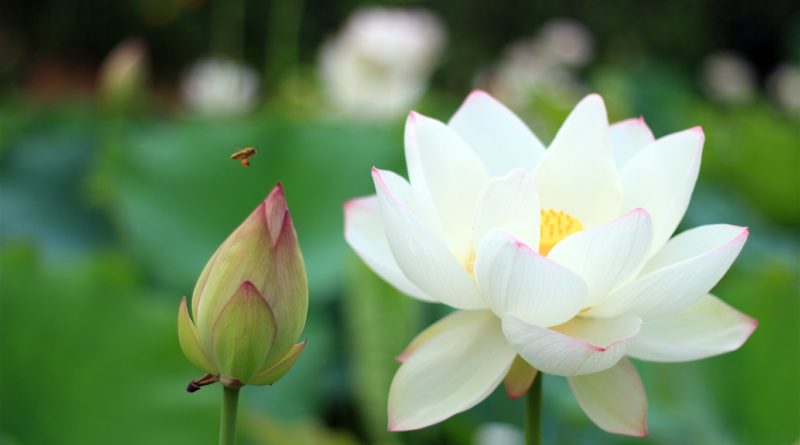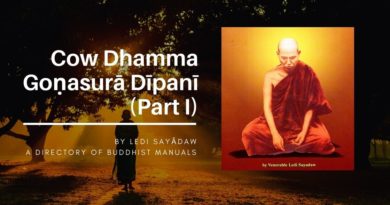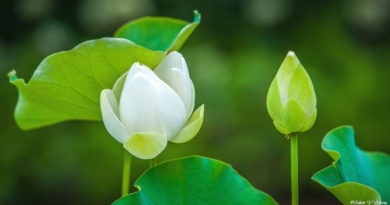ABHIDHAMMA IN DAILY LIFE – CHAPTER 24: ENLIGHTENMENT
ABHIDHAMMA IN DAILY LIFE – CHAPTER 24: ENLIGHTENMENT
- One cannot attain enlightenment without having cultivated the right conditions.
- What are the conditions for enlightenment?
- We read in the ‘Kindred Sayings’ (V, Maha-vagga, Book XI, Kindred Sayings on Streamwinning, Ch. I, par. 5, Sariputta) about four conditions for becoming a sotapanna (streamwinner). The sutta states:
Now the venerable Sariputta went to see the Exalted One, and on coming to him saluted him and sat down at one side. To the venerable Sariputta so seated the Exalted One said this:
”A limb of stream-winning! A limb of stream-winning!’ is the saying, Sariputta. Tell me, Sariputta, of what sort is a limb of stream-winning.’
‘Lord, association with the upright is a limb of stream-winning. Hearing the good Dhamma is a limb of stream-winning. Applying the mind is a limb of stream-winning. Conforming to the Dhamma is a limb of stream-winning.’
‘Well said, Sariputta! Well said, Sariputta! Indeed these are limbs of stream-winning.
Now again, Sariputta, they say: ‘The stream! the stream!’ Of what sort is the stream, Sariputta?’
‘The stream, lord, is just this Ariyan Eightfold Way, to wit: right view, right thought, right speech, right action, right livelihood, right effort, right mindfulness, right concentration.’
‘Well said, Sariputta! Well said, Sariputta! The stream is just this Ariyan Eightfold Way.
Now again, Sariputta, they say, ‘Stream-winner! Stream-winner!’ Of what sort is a stream-winner, Sariputta?’
‘Whosoever, lord, is blessed with this Ariyan Eightfold Way,– such an one of such a name, of such and such a clan, is called ‘Stream-winner.”
- As regards the first condition, association with the righteous person, is this essential? Would it not be possible to find the right path by oneself?
- Only Buddhas have accumulated such wisdom that they can find the Path by themselves, without the help of a teacher. Other people, however, need the teachings of a Buddha in order to find the right path, because ignorance has been accumulated for an endlessly long time. We need association with the right person, the good friend in Dhamma, who can point out to us the right path, because our defilements prevent us from finding the right path. Our friend in Dhamma can encourage us to develop mindfulness of nama and rupa.
- What should one do if there is no such friend in Dhamma, who can point out the right way of practice?
- Reading the Buddhist scriptures is very helpful. The teachings can encourage us to be mindful of nama and rupa in daily life. We might, however, interpret the teachings in the wrong way. It depends on conditions whether we come into contact with the right person who can help us to understand the teachings and the practice in accordance with the teachings. Accumulated kusala kamma can be the condition for us to meet the right person.
- How can we find out whether we really understand the teachings and practise the right path?
- We can find out through the practice. If we practise in the wrong way we may eventually find out that it does not lead to right understanding of the realities of our daily life.
When we have heard the Dhamma from the right person, we should ‘apply the mind’; this is the third condition. We should not blindly follow the person who teaches us Dhamma, but we should investigate the scriptures ourselves, ponder over the Dhamma, and consider it carefully, in order to test the truth.
The real test of the truth is the practice itself. Therefore, the fourth condition is ‘conforming to the Dhamma’, which is the practice: the development of the Eightfold Path. By being mindful of the phenomena appearing through the six doors we can prove whether it is true that these phenomena are only nama and rupa, arising because of conditions. We can prove whether they are impermanent or permanent, whether they are dukkha or happiness, whether they are anatta or ‘self’. Through the practice we will have more confidence (saddha) in the Buddha’s teachings. We will have more confidence when we experience that through right understanding of nama and rupa in daily life and there will be less clinging to ‘self’.
Lokuttara cittas cannot arise without the cultivation of the right conditions. Some people wish for an end to dukkha but they do not develop understanding in daily life. They hope that one day lokuttara cittas will arise. The Buddha pointed out that the realization of the Four Noble Truths is difficult, not in order to discourage people, but in order to remind them not to be heedless.
We read in the ‘Kindred Sayings’ (V, Maha-vagga, Book XII, Kindred Sayings about the Truths, Ch. V, par. 5, The keyhole) that Ananda watched in Vesali the Licchavi youths practising archery. He went to see the Buddha and said:
‘Here, lord, robing myself in the forenoon and taking bowl and outer robe I set out for Vesali on my begging rounds. Then, lord, I saw a number of Licchavi youths in the gymnasium making practice at archery, shooting even from a distance through a very small keyhole, and splitting an arrow, shot after shot, with never a miss. And I said to myself, lord: ‘Practised shots are these Licchavi youths! Well practised shots indeed are these Licchavi youths, to be able even at a distance to splinter an arrow through a very small keyhole, shot after shot, with never a miss!’ ‘
‘Now what think you, Ananda? Which is the harder, which is the harder task to compass: To shoot like that or to pierce one strand of hair, a hundred times divided, with another strand?’
‘Why, lord, of course to split a hair in such a way is the harder, much the harder task.’
‘Just so, Ananda, they who penetrate the meaning of: This is dukkha, this is the arising of dukkha, this is the ceasing of dukkha, this is the practice that leads to the ceasing of dukkha, pierce through something much harder to pierce.
Wherefore, Ananda, you must make an effort to realize: This is dukkha. This is the arising of dukkha. This is the ceasing of dukkha. This is the practice that leads to the ceasing of dukkha.’
- I really feel discouraged when I hear this sutta. It seems that it is impossible to attain enlightenment.
- If one develops the right Path, not the wrong Path, one will know the Four Noble Truths: one will attain enlightenment. The way to know the Four Noble Truths is to be mindful of the realities which appear now: seeing, visible object, lobha, dosa or any other reality. We should not be discouraged when we do not seem to make rapid progress. Most people cling to a result and they become impatient when they do not notice an immediate result; clinging to a result, however, is not helpful for the development of wisdom, it is akusala.
Some people feel that the development of samatha can give a more immediate result. Samatha, when it is developed, has tranquillity as its result. When jhana is attained, lobha, dosa and moha are temporarily eliminated. However, the attainment of jhana is extremely difficult and many conditions have to be cultivated. When one cultivates samatha, but one cannot attain ‘access-concentration’ or jhana, the five hindrances are bound to arise: there will be sensuous desire, ill-will, sloth and torpor, restlessness and worry, and doubt.
The aim of vipassana is not tranquillity, but the eradication of wrong view and eventually of all defilements. This goal may seem far off, but each short moment of right awareness of nama or rupa is very fruitful; it will help to eliminate clinging to the concept of self. While one is mindful, there is no lobha, dosa or moha. Although tranquillity is not the aim, at the moment of right mindfulness the kusala citta is peaceful.
- Is enlightenment or the experience of nibbana the same as thinking about nibbana?
- Is the direct experience of the characteristics of nama and rupa the same as thinking about them?
- No, it is different.
- Even so is the direct experience of nibbana different from thinking about it.
- Through which door does the person who attains enlightenment experience nibbana?
- Nibbana cannot be experienced through any of the five senses, it is experienced through the mind-door.
- Objects which contact the five sense-doors or the mind-door are experienced by cittas arising in processes of citta. What is the process of cittas like which experience nibbana? How many cittas experience nibbana directly?
- The person who is about to attain enlightenment has developed the knowledge of conditioned realities in the practice of vipassana. He has realized the characteristics of nama and rupa more and more clearly and he experiences their arising and falling away. Panna has been developed to the degree that it can realize the nama and rupa which present themselves through the six doors as anicca (impermanent), dukkha and anatta (not self). In the process during which enlightenment is attained, the mano-dvaravajjana-citta (mind-door- adverting-consciousness) takes as its object one of the three characteristics of reality: anicca, dukkha or anatta.
- I understand that anicca, dukkha and anatta are three aspects of the truth of conditioned realities. Thus, if one sees one aspect, one also sees the other aspects. Why can one not experience the three characteristics at the same time?
- Cittas can experience only one object at a time. It depends on one’s accumulations which of the three characteristics is realized in the process of cittas during which enlightenment is attained: one person views the reality appearing at that moment as anicca, another as dukkha, and another again as anatta.
The mano-dvaravajjana-citta of that process adverts to one of these three characteristics and is then succeeded by three or four cittas which are not yet lokuttara cittas. but maha-kusala cittas (kusala cittas of the sensuous plane of consciousness), accompanied by panna. The first maha-kusala citta is called parikamma, and it still has the same object as the mano-dvaravajjana-citta. If the mano-dvaravajjana-citta had anicca as the object, parikamma realizes the characteristic of anicca.
- What does parikamma mean?
- Parikamma means preparatory. The citta is called ‘preparatory’ because it is the first of the maha-kusala cittas before the lokuttara cittas in that process arise. The parikamma is succeded by upacara, which still has the same object as the mano-dvaravajjana-citta.
- What does upacara mean?
- Upacara means proximatory. This citta, which is the second maha-kusala citta in that process, is nearer to the moment the lokuttara cittas will arise.
The upacara is succeeded by the anuloma, which still has the same object as the mano-dvaravajjana-citta.
- What does anuloma mean?
- Anuloma means adaptation. Anuloma is succeeded by gotrabhu which is the last citta of the sensuous plane of consciousness; it is the last kamavacara citta in that process. Gotrabhu is sometimes translated as ‘change of lineage’.
- I have heard that in the practice of samatha there is gotrabhu as well. Is the gotrabhu in samatha the same type of citta, or is there a difference between gotrabhu in samatha and gotrabhu in vipassana
- Gotrabhu is the last kamavacara citta in a process, before a citta of another plane of consciousness arises in that process. The other plane of consciousness may be rupavacara (in the case of rupa-jhana), arupavacara (in the case of arupa-jhana) or lokuttara.
In samatha, gotrabhu is the last kamavacara citta before the rupa-jhanacitta or the arupa-jhanacitta arises. In vipassana, gotrabhu is the last kamavacara citta of the non-ariyan before the lokuttara citta arises and he becomes an ariyan. The object of the gotrabhu arising before the lokuttara citta is different from the object of gotrabhu in samatha.
- What is the object of gotrabhu which arises before the lokuttara citta?
- Gotrabhu arising before the lokuttara citta has nibbana as object.
- Why is gotrabhu not lokuttara citta? It is the first citta which has nibbana as object.
- At the moment of gotrabhu the person who is about to attain enlightenment is still a non-ariyan. Gotrabhu does not eradicate defilements. Gotrabhu is succeeded by the magga-citta which eradicates the defilements that are to be eradicated at the stage of the sotapanna. The magga-citta is the first lokuttara citta in that process of cittas. When it has fallen away it is succeeded by two (or three) phala-cittas which are the result of the magga-citta and which still have nibbana as the object. As we have seen, the magga-citta is succeeded immediately by its result, in the same process of citta. The magga-citta cannot produce vipaka in the form of rebirth, such as the kusala citta of the other planes of consciousness. The phala-cittas are succeeded by bhavanga-cittas.
Some people do not need the moment of parikamma (preparatory consciousness) and in that case three moments of phala-citta arise instead of two moments.
Summarizing the process of citta, during which enlightenment is attained, it is as follows:
– mano-dvaravajjana-citta (mind-door-adverting-consciousness)
– parikamma (preparatory; for some people not necessary)
– upacara (proximatory)
– anuloma (adaptation)
– gotrabhu (change of lineage)
– magga-citta
– phala-citta (two or three moments, depending on the individual)
- When the lokuttara cittas have fallen away and there are kamavacara cittas again, can nibbana also be the object of kamavacara citta?
- Nibbana can be the object of kamavacara-cittas which arise after the lokuttara cittas have fallen away. Before someone becomes an ariyan there can only be speculation about nibbana. Since the ariyan, however, directly experiences nibbana, he can reflect upon his experience afterwards.
We read in the ‘Visuddhimagga’ (XXII, 19) that, after the lokuttara cittas have fallen away, the person who attained enlightenment reviews in different mind-door processes of citta the path, fruition, the defilements which have been abandoned, the defilements still remaining and nibbana.
- Could enlightenment occur in the middle of one’s daily activities or is it necessary to go into solitude in order to attain nibbana?
- Since we cultivate wisdom in daily life, why could the development of wisdom to the degree of enlightenment not occur in daily life? Enlightenment can occur in the middle of one’s daily activities if the wisdom is developed to that degree. As we have seen, the attainment of nibbana is only a few moments of citta which arise and fall away within split seconds.
We read in the ‘Discourse to Dighanakha’ (Middle Length Savings II, No. 74) that the Buddha taught Dhamma to the wanderer Dighanakha on Vulture’s Peak near Rajagaha. He taught him about the getting rid of wrong views and about the impermanence of conditioned realities. Sariputta, who was an ariyan but had not attained arahatship, was also present at the time of that discourse. We read:
Now at that time the venerable Sariputta was standing behind the Lord, fanning the Lord. Then it occurred to the venerable Sariputta:
‘The Lord speaks to us of getting rid of these things and those by means of super-knowledge, the Well-farer speaks to us of casting out these things and those by means of superknowledge’. While the venerable Sariputta was reflecting on this, his mind was freed from the cankers without clinging…
Sariputta did not go into solitude in order to attain arahatship; he was fanning the Buddha.
We read in the ‘Kindred Sayings’ (V, Khandha-vagga, Middle Fifty, Par. 89, Khema) that Khemeka, who was an anagami attained arahatship while he was preaching and monks who were listening attained arahatship as well. We read:
Now when this teaching was thus expounded the hearts of as many as sixty monks were utterly set free from the asavas, and so was it also with the heart of the venerable Khemaka.
If one is on the right path, panna can be developed, no matter what the circumstances are, even to the degree of enlightenment.
- Would someone else be able to notice it when a person attains nibbana?
- Can you see whether someone else is mindful or not mindful? Who knows the cittas of other people? If we haven’t developed the ‘supernormal power’ (abhinna) of knowing the cittas of other people, we cannot know when someone else is mindful of nama and rupa or when he attains nibbana.
- Can one attain, in the course of one life, the four stages of enlightenment, which are the stages of the sotapanna, the sakadagami, the anagami and the arahat?
- All four stages can be attained in the course of one life. We read in the suttas about disciples of the Buddha who attained the ariyan state but not yet arahatship and realized arahatship later on. For example, Ananda did not attain arahatship during the Buddha’s life, but he became an arahat after the Buddha had passed away, the evening before the first great council was to start.
- The arahat has eradicated all defilements and thus he has reached the end of the cycle of birth, old age, sickness and death; he has realized the end of dukkha. He will not be reborn, but he still has to die; therefore, has he really attained the end of dukkha at the moment he realizes arahatship?
- Even the arahat is subject to death, since he was born. He can also experience unpleasant results of akusala kamma committed before he attained arahatship. However, since he has no more defilements and cannot accumulate any more kamma which might produce vipaka, he is really free from sorrow.
In ‘As it was said’ (‘ltivuttaka’, Ch. II, par. 7, ‘Khuddaka Nikaya’) two ‘conditions of nibbana’ (dhatu, which literally means element) are explained. Sa-upadi-sesa nibbana is nibbana with the five khandhas still remaining. For the arahat who has not finally passed away yet, there are still citta, cetasika and rupa arising and falling away, although he has eradicated all defilements. An-upadi-sesa nibbana is nibbana without the khandhas remaining. For the arahat who has finally passed away, there are no longer citta, cetasika and rupa arising and falling away.
We read in the verse, after the explanation:
These two nibbana-states are shown by him
Who sees, who is such and unattached.
One state is that in this same life possessed.
With base remaining, though becoming’s stream
Be cut off. While the state without a base
Belongs to the future, wherein all
Becomings utterly do come to cease.
They who, by knowing this state uncompounded
Have heart’s release, by cutting off the stream,
They who have reached the core of dhamma, glad
To end, such have abandoned all becomings.
- When one has become an arahat there will be no more rebirth. If one only attains the stage of the sotapanna in the course of one’s life, how many more times does one have to be reborn?
- The sotapanna will not be reborn more than seven times; thus, eventually there will be an end to rebirth for him. If we do not cultivate vipassana, the number of rebirths will be endless. It was out of compassion that the Buddha spoke about the dangers of rebirth; he wanted to encourage people to develop mindfulness.
We read in the ‘Kindred Sayings’ (V, Maha-vagga, Book XII, Kindred Sayings about the Truths, Ch. V, part 6, Gross darkness) that the Buddha said to the monks:
‘Monks, there is a darkness of interstellar space, impenetrable gloom, such a murk of darkness as cannot enjoy the splendour of this moon and sun, though they be of such mighty magic power and majesty.’
At these words a certain monk said to the Exalted One:
‘Lord, that must be a mighty darkness, a mighty darkness indeed! Pray, lord, is there any other darkness greater and more fearsome than that?’
‘There is indeed, monk, another darkness, greater and more fearsome. And what is that other darkness?
Monk, whatsoever recluses or brahmins understand not, as it really is, the meaning of: This is dukkha, this is the arising of dukkha, this is the ceasing of dukkha, this is the practice that leads to the ceasing of dukkha, such take delight in the activities which conduce to rebirth. Thus taking delight they compose a compound of activities which conduce to rebirth. Thus composing a compound of activities they fall down into the darkness of rebirth…and despair. They are not released from birth, and death…and despair. They are not released from dukkha, I declare.
But, monk, those recluses or brahmins who do understand as it really is, the meaning of : This is dukkha, this is the practice that leads to the ceasing of dukkha, such take not delight in the activities which conduce to rebirth…They are released from dukkha, I declare.
Wherefore, monk, an effort must be made to realize: This is dukkha. This is the arising of dukkha. This is the ceasing of dukkha. This is the practice that leads to the ceasing of dukkha.’









